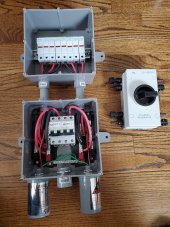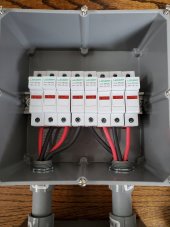I put my entire system in a metal building (my workshop) 100 feet away from the house, used direct-buried 3C6AWG to the house for my critical loads panel and another line beside it to feed utility power back to the system for the short cloudy days we get in Nov-Feb. Part of the reason was to keep the solar off my house, and part was to keep my wife off my back! LOL
Seriously, though, the inverter-fans, the space it all takes, wiring and upgrades, it just made sense to keep most of it out of the house for me.
I used 100A T-class fuses & MCCB breakers between my tower 600A buss bar and each rack battery, I put a 2P 300A MCCB breaker between the buss bars and the terminal blocks supplying the two inverters so I have a single breaker handle that will cut all DC battery power in one device, and I put 300A T-class fuses between each inverter-positive and the terminal blocks.
On the PV side I put DC fuses on each string, an Exterior Disconnect that cuts off all PV to the building, and Interior Fused Disconnect between the Inverters and the incoming PV. I followed all the CEC (similar to the NEC you guys have) for grounding of the PV system and fusing. The only item I am not 100% sure of is the required DC Arc-Fault detection/interruption which is not a simple breaker you can buy like AC AFDD. DC arc-fault is hard to find, and generally we mostly rely on the Inverter to have this internally. Does it? and is it compliant? not sure. I asked the folks at Tomzn (who supplied my MCCB's) if they had or could come up with a DC rated AFDD DIN-rail mounted breaker for a combiner box mounting between the inverters and the PV - guess we will see.




